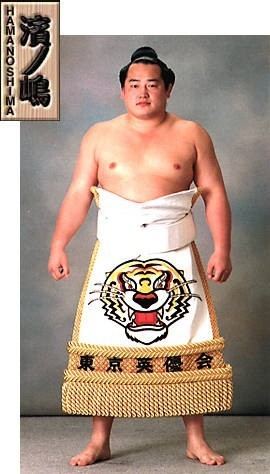Record 447-495-23 Name Hamanoshima Keishi Weight 125 kg Championships 1 (Juryo) Height 1.79 m | Retired May, 2004 Makuuchi rank Komusubi Debut January, 1992 Role Sumo Wrestler Career start January 1992 | |
 | ||
Highest rank Komusubi (September, 1994) Special Prizes Outstanding Performance (1) Similar People Asanowaka Takehiko, Akinoshima Katsumi, Tomonohana Shinya, Tochinowaka Kiyotaka, Tamakasuga Ryoji | ||
Hamanoshima keishi top 9 facts
Hamanoshima Keishi (濱ノ嶋 啓志, born 21 March 1970 as Keishi Hamasu) is a former sumo wrestler from Uto, Kumamoto Prefecture, Japan. A former amateur champion, he turned professional in 1992, reaching the top makuuchi division in 1994. His highest rank was komusubi. After his retirement from active competition in 2004 he became an elder of the Japan Sumo Association and founded Onoe stable in 2006, which has produced a number of top division wrestlers.
Contents
Career
He took part in national sumo competitions at high school and was an amateur champion at Nihon University, where he was a contemporary of the future maegashira Higonoumi. He made his professional debut in January 1992, joining Mihogaseki stable. He had makushita tsukedashi status because of his amateur achievements and so began at the bottom of the makushita division. He won the jūryō division championship in September 1993 with an 11–4 record. He reached the top makuuchi division in January 1994. In July of the same year he won the Outstanding Performance Award for defeating tournament winner Takanohana, which proved to be his only special prize. He reached his highest rank of komusubi the following tournament in September 1994, but scored only six wins against nine losses and never made the rank again. Suffering from diabetes he was demoted from the top division in March 2001 after 39 consecutive tournaments as a maegashira, and after being demoted from the jūryō division in January 2002 he fought in the unsalaried makushita division for the last two years of his career.
Retirement from sumo
He retired in May 2004, becoming an elder of the Japan Sumo Association under the name Onoe Oyakata. His danpatsu-shiki or official retirement ceremony was held in the Ryōgoku Kokugikan in January 2005. In August 2006 he branched out from Mihogaseki and set up his own Onoe stable, against the wishes of his old stablemaster Mihogaseki Oyakata (who had wanted him to stay and eventually inherit Mihogaseki stable). Onoe took with him six wrestlers he had recruited, including the top division wrestler Baruto and jūryō Satoyama. This marked the first time since Aobajō left Nishonoseki stable for Oshiogawa stable in 1975 that a makuuchi wrestler had left an established stable for a newly founded one. The Sumo Association subsequently tightened the rules for branching out, requiring elders wishing to set up their own stables to have at least 60 tournaments in the top division or 25 in san'yaku (which Onoe Oyakata did not have).
In April 2011 three of his wrestlers (Yamamotoyama, Shirononami and Sakaizawa) were forced to retire by the Japan Sumo Association because of match-fixing. Onoe was demoted two ranks in the Association' elder hierarchy as punishment. In the same month he was found by police to be allegedly driving while intoxicated. Onoe apologised for his actions at a press conference.
Fighting style
Hamanoshima was a yotsu-sumo wrestler, who preferred grabbing the mawashi to pushing or thrusting. He favoured a hidari-yotsu grip, with his right hand outside and left hand inside his opponent's position. His most common winning kimarite was a straightforward yori-kiri or force out. He was also fond of tsuki-otoshi, or thrust over. He was known for stalling at the tachi-ai to unsettle his opponents.
